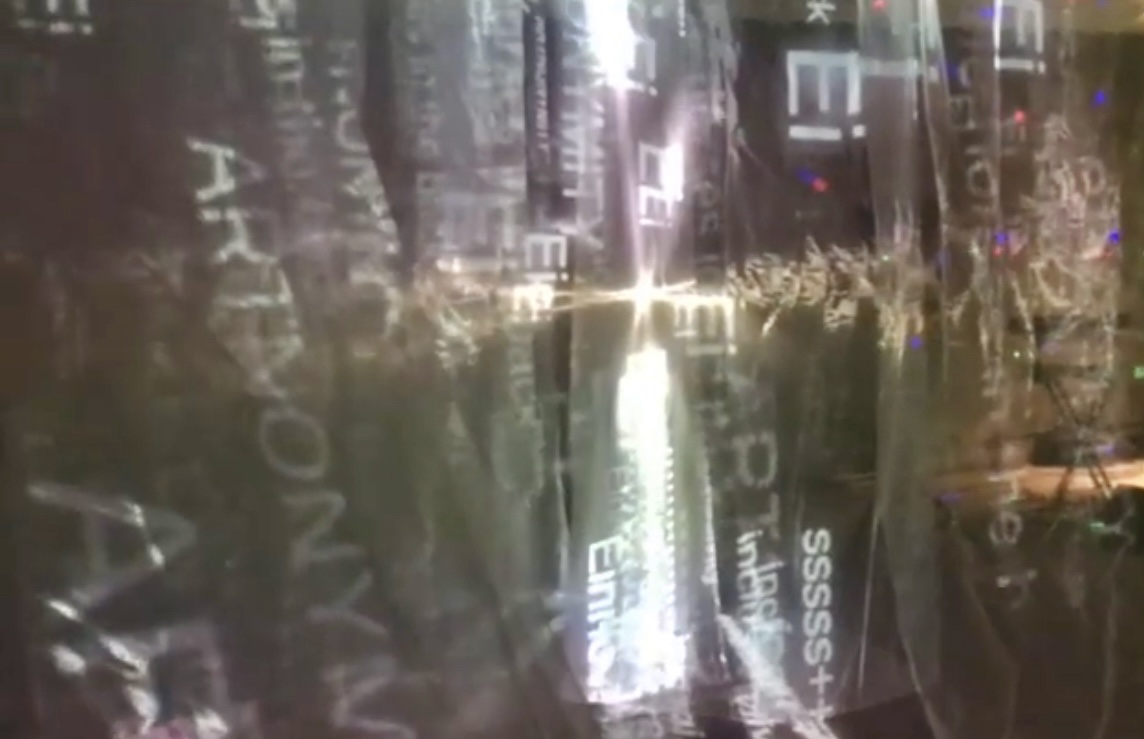artnomity
Click "Block Editor" to enter the edit mode. Use layers, shapes and customize adaptability. Everything is in your hands.

Tilda Publishing
create your own block from scratch
75%
60%
30%
women outnumber
men at art universities
men at art universities
female artists
represented
by galleries
represented
by galleries
Promote visual artists through a hidden identity
Change perceptions & assumptions
To make fine art world equal
Develop an awareness, educate & create experience
How it works
THE APPROACH
Strategy
Women Outnumber Men at Art Universities
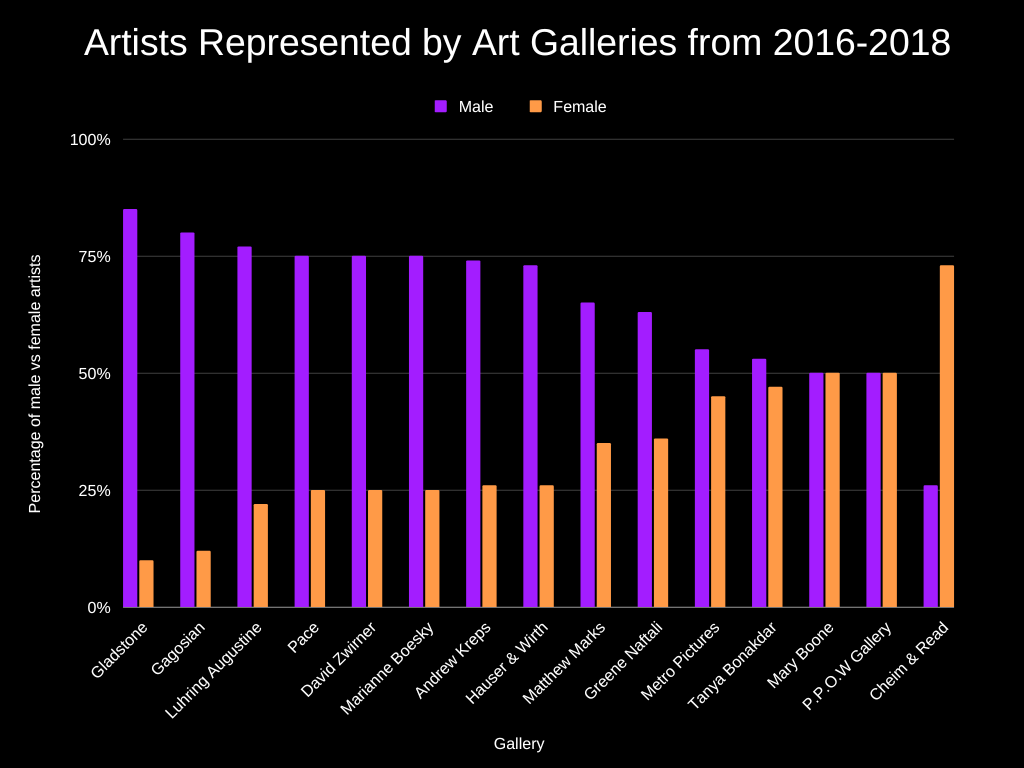
Based on 1.5m auction transactions between 1970 to 2013 in 45 countries for 62,665 artists, the average transaction price for men is $48,212 and for women $25,262 (Shaw, 2017).
Art auction prices reveal that female artists’ works make on average 47.6% less than male artists’ works at auction (Sutton, 2017).
Art auction prices reveal that female artists’ works make on average 47.6% less than male artists’ works at auction (Sutton, 2017).
Uneducated Collectors
Discrimination
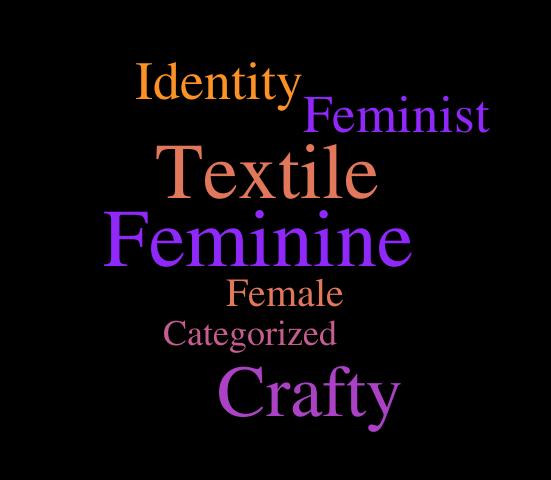
Female artists' work is often critiqued at being feminine, craft-related or textile because of their gender. Female artists do not like to be categorized as “female” artists/work. They feel that artists should not be identified by gender.
During my interview with Helen Downie, I have asked about her opinion on gender specification and this is what she said.
“It’s just ridiculous. I find it ridiculous. You don’t get male artists anyway, do you? You just get artists and ”female” artists or artists and “black” artists.”
(Helen Downie, British)
Everyone I have interviewed or surveyed mentioned this in their answer. The problem with categorizing or labeling people is that it is unfair. Labelling allows us to put ourselves in a different category, artificially separating us from that which we believe we are not.
By putting on labels such as ‘crafty’ or ‘feminine’, it is showing women that they do not belong in men’s world.
During my interview with Helen Downie, I have asked about her opinion on gender specification and this is what she said.
“It’s just ridiculous. I find it ridiculous. You don’t get male artists anyway, do you? You just get artists and ”female” artists or artists and “black” artists.”
(Helen Downie, British)
Everyone I have interviewed or surveyed mentioned this in their answer. The problem with categorizing or labeling people is that it is unfair. Labelling allows us to put ourselves in a different category, artificially separating us from that which we believe we are not.
By putting on labels such as ‘crafty’ or ‘feminine’, it is showing women that they do not belong in men’s world.
I wanted to learn in more depth about real situations that female artists have experienced in their journey. So, I have interviewed Aboli Shah, who is quite famous back in India, to learn about her journey and pain points throughout her career. I received some really valuable insights from her.
“Sorry we cannot have your work up there because you’re not as experienced as the other artists”
“I went to that gallery and what I saw is that 90% of the artists were male artists and a couple of them were not as experienced as I was, and only 2 artists were female artists and they were relatives of the people who were opening the gallery.”
(Aboli Shah, Indian, 26)
Her experienced confirmed my assumption that gallerists select work based on gender or connections and not quality.
“Sorry we cannot have your work up there because you’re not as experienced as the other artists”
“I went to that gallery and what I saw is that 90% of the artists were male artists and a couple of them were not as experienced as I was, and only 2 artists were female artists and they were relatives of the people who were opening the gallery.”
(Aboli Shah, Indian, 26)
Her experienced confirmed my assumption that gallerists select work based on gender or connections and not quality.


Key Topics
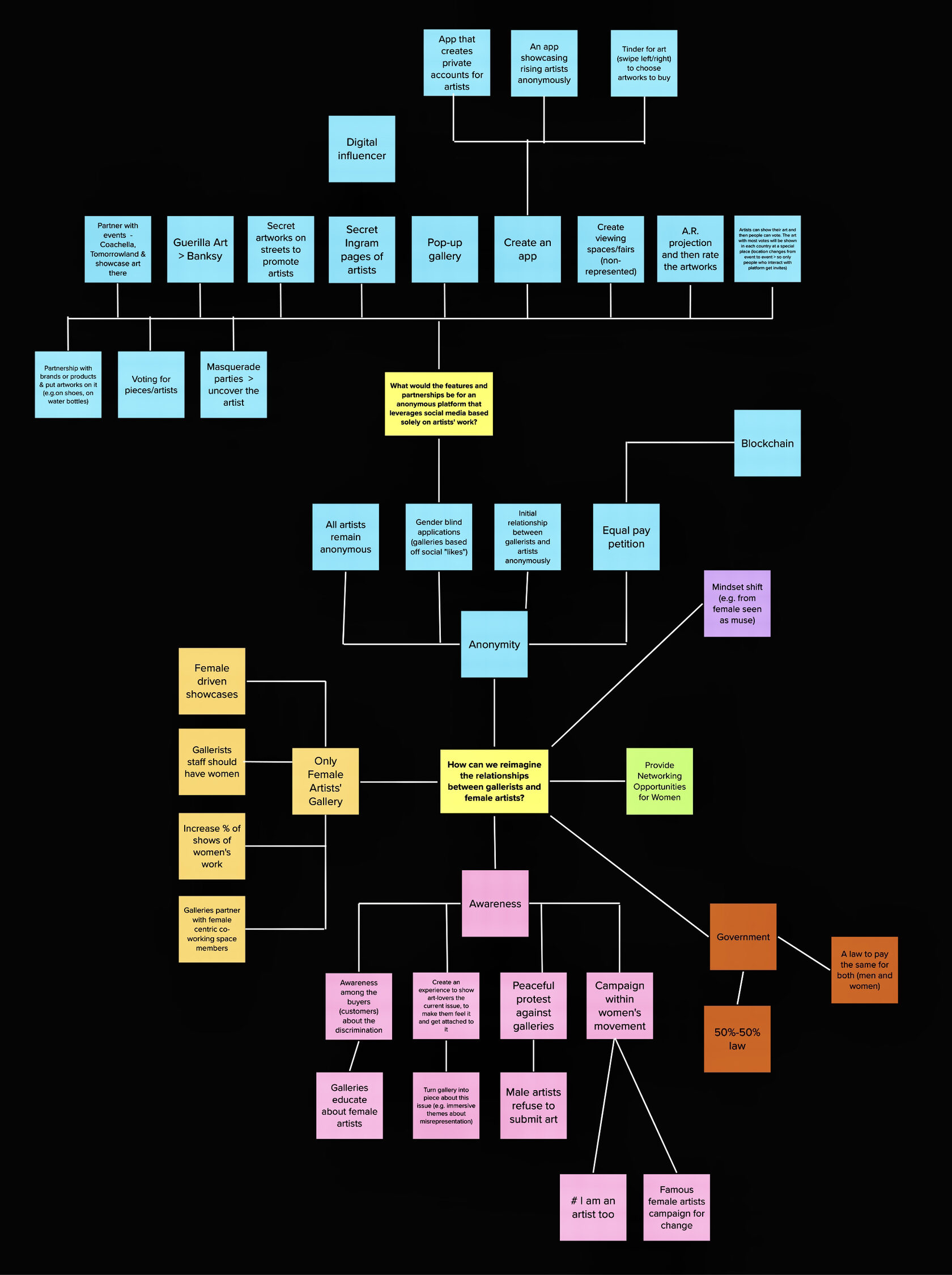
What would the features and partnerships be for an anonymous platform that leverages social media based solely on artists' work?
New Question is Formed
Part 2
The idea was to test out the reveal (in terms of branding). How should the reveal look like? Should the artist be behind its own paintings or should the artist be behind ARTNONYMITY branding?
The idea was to test out the reveal (in terms of branding). How should the reveal look like? Should the artist be behind its own paintings or should the artist be behind ARTNONYMITY branding?

Prototype (Instagram)
Part 3
I wanted to know what art lovers want to see on Instagram (specifying if it’s within the feed or a story). Also, what language would be the most engaging to use.
I wanted to know what art lovers want to see on Instagram (specifying if it’s within the feed or a story). Also, what language would be the most engaging to use.
Artnonymity’s Instagram followers have increased from 116 to 146 after two weeks of talking about two artists’ stories. Women seemed to be more engaing with reading stories and the age range of audience who were more engaged was from 25-34. One of the famous artist from India (@abolishah07) even reposted Artnonymity on her Instagram feed. People were engaged with artists' stories, some also commented.
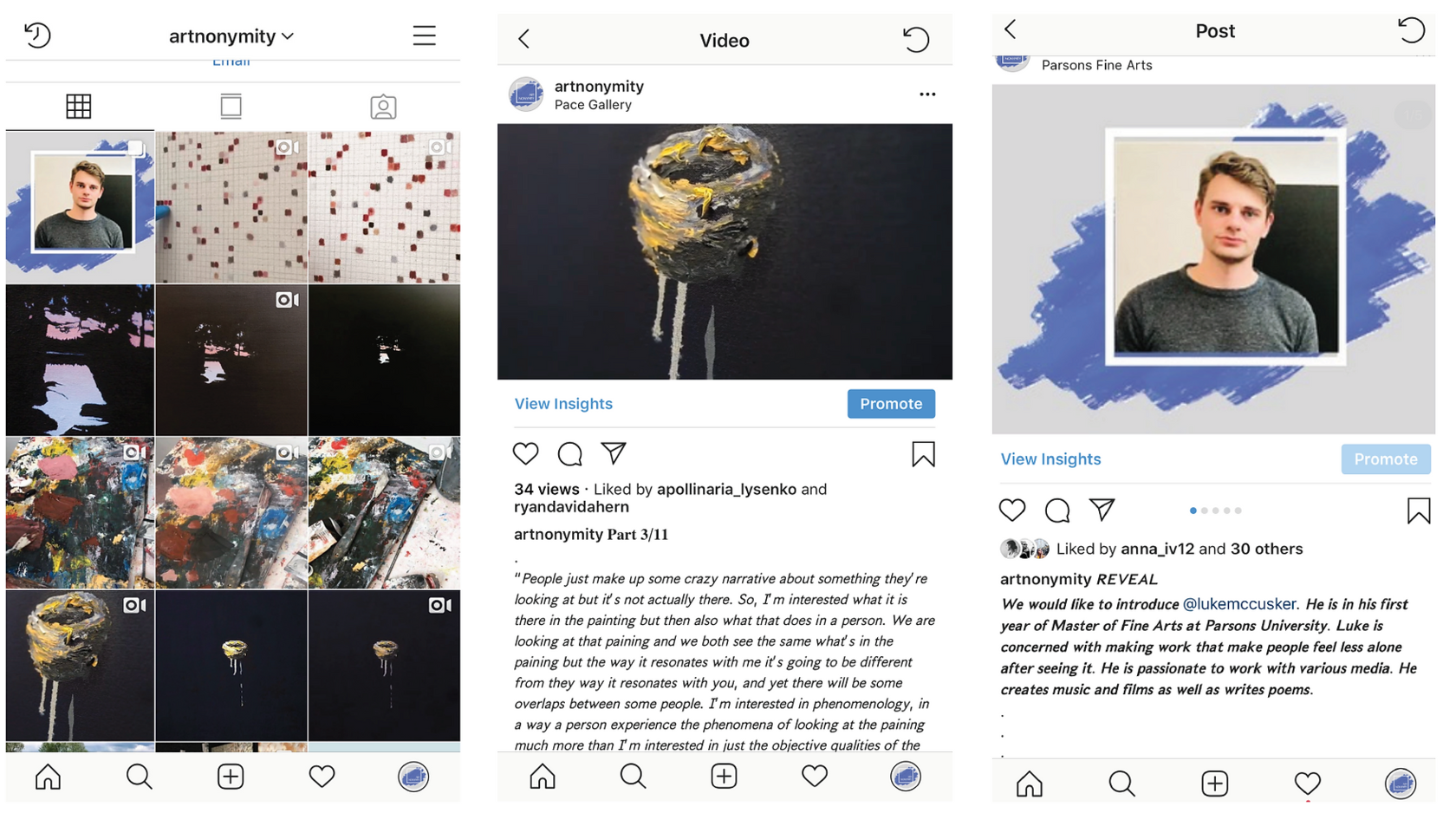
Workshop (Experience)
During this workshop, the goal was to understand people’s wants and needs from pop-up experience organized by Artnonymity. The image on the left represents the storyboard from the entrance to the exit of how the Artnonymity’s event should be running.

Prototype (Experience)
On 26th April, 2019 I had a chance to partner with a new start-up Collabaret to prototype some elements of experience for Artnonymity’s pop-up event.
I’ve networked with art-lovers as well as many artists and all of them were very interested in the idea. I gave away around 20 business cards. There was one artists Erink Ko who did the installation where people could send messages from their phone and I promoted Artnonymity. By the end of the event a few new people followed Artnonymity on Instagram.
I also represented one of my artist at the event anonymously with a story description aside and people were interested to know the artist behind the work. This indicated that the idea could work.
I’ve networked with art-lovers as well as many artists and all of them were very interested in the idea. I gave away around 20 business cards. There was one artists Erink Ko who did the installation where people could send messages from their phone and I promoted Artnonymity. By the end of the event a few new people followed Artnonymity on Instagram.
I also represented one of my artist at the event anonymously with a story description aside and people were interested to know the artist behind the work. This indicated that the idea could work.
78%
44%
33%
U.S. millennial collectors acquired art online in 2018
18-24 discover art through social media and would buy art online
25-34 discover art through social media & would buy art online
57%
52%
Michael Xufu Huan
Tiffany Zabludowicz
Artnonymity's Ecosystem


Competitive Analysis
BRANDING
SERVICE DESIGN
STORYTELLING
SERVICE DESIGN
STORYTELLING
THE CHALLENGE
How can we reimagine the relationship between gallerists and female artists to be more equitable?
Women make up 60-75% of those studying fine art at a university level, a report on gender disparity in the arts compiled by the National Museum of Women in the Arts showed that female artists rarely comprise more than 30% of the artists shown in museums and galleries. And not only that, they earn nearly 50% less than male artists. I was determined to tackle the biases in the art market, and that was the beginning of Artnonymity.


Digital PR agency for emerging visual artists.
Artnonymity brings equity to the fine art world by building audience endorsement for visual artists through a process of social media reveals and immersive experiences.
Artnonymity brings equity to the fine art world by building audience endorsement for visual artists through a process of social media reveals and immersive experiences.
THE SOLUTION
47.6%

female artists’
work make less
than male artists’
work at auction
work make less
than male artists’
work at auction
Observation
When I went to art galleries around the Chelsea area, I noticed that there are more male artists displayed than female artists. So, I went back home and analyzed if my observations were correct. I found that from 2016 to 2018, more male artists have been featured at the galleries except at Cheim & Read where women outnumber men.



When I interviewed Helen, I found out that she doesn’t like galleries because of uneducated collectors.
“The only benefit for me in having a gallery would be the type of cliental they sell to. So, the only reason for me to want my work with collectors is that they would look after it and they will understand how to look after it.”
“The thought that it’s going to somebody that doesn’t know how to look after it is terrifying and I really dislike it. So I don’t sell a lot of work. I keep it back because of that.”
(Helen Downie, British)
Many collectors do not know how to take care of the painting. Usually, they buy artwork for investment purposes. Many are buying art who do not know much about art (Avrich, 2017). This made me think about the question of how can we educate collectors to take care of a painting?
“The only benefit for me in having a gallery would be the type of cliental they sell to. So, the only reason for me to want my work with collectors is that they would look after it and they will understand how to look after it.”
“The thought that it’s going to somebody that doesn’t know how to look after it is terrifying and I really dislike it. So I don’t sell a lot of work. I keep it back because of that.”
(Helen Downie, British)
Many collectors do not know how to take care of the painting. Usually, they buy artwork for investment purposes. Many are buying art who do not know much about art (Avrich, 2017). This made me think about the question of how can we educate collectors to take care of a painting?

UX RESEARCH
STRATEGY
BUSINESS MODELLING
STRATEGY
BUSINESS MODELLING
An individual project.

Motherhood
Labels


Target Market
Millennials who develop a deep fascination with art often start their collections early, as young as their teenage years. Michael Xufu Huang and Tiffany Zabludowicz are two such examples, who both began collecting at age sixteen.
There is an opportunity to target young millennials who don't see gender as a negative bias but see it as a potential untapped undervalued emerging market with potential.
There is an opportunity to target young millennials who don't see gender as a negative bias but see it as a potential untapped undervalued emerging market with potential.
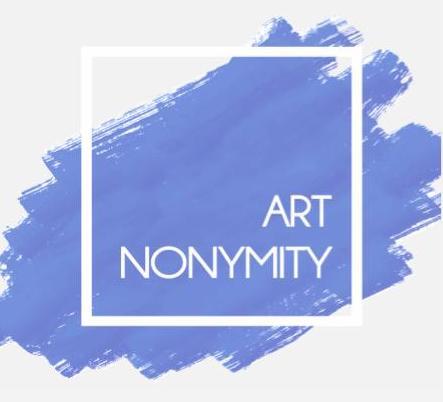

From my survey, I gained some interesting insights which I wanted to explore further.
To the question “were there more women or men in the art program?” the majority of artists selected women as their answer. A further desk research supported my findings. Women make up 60-75% of those studying art at a university level, but only 30% of artists shown in museums and galleries (Fard, 2017).
Why do we see just a small number of women in the galleries? What is the reason behind it?
To the question “were there more women or men in the art program?” the majority of artists selected women as their answer. A further desk research supported my findings. Women make up 60-75% of those studying art at a university level, but only 30% of artists shown in museums and galleries (Fard, 2017).
Why do we see just a small number of women in the galleries? What is the reason behind it?
I started off with the secondary research around auction houses to gain a better understanding of the artworks’ pricing in the secondary market. The numbers from the research surprised me.
In 2017, only 13 female artists out of the top 100 artists were featured at auction whose works brought the highest amounts (Youngs, 2018).
Yayoi Kusama was the top female artist, whose works sold for $65.6 million. This placed her on 13th place in the ranking, according to figures from MutualArt.
Leonardo da Vinci was top of the 2017 auction ranking with a $450 million sales of the Salvator Mundi Painting. Followed by Jean Michel Basquiat ($338m), then Andy Warhol, Cy Twombly, and Roy Lichtenstein.
In 2017, only 13 female artists out of the top 100 artists were featured at auction whose works brought the highest amounts (Youngs, 2018).
Yayoi Kusama was the top female artist, whose works sold for $65.6 million. This placed her on 13th place in the ranking, according to figures from MutualArt.
Leonardo da Vinci was top of the 2017 auction ranking with a $450 million sales of the Salvator Mundi Painting. Followed by Jean Michel Basquiat ($338m), then Andy Warhol, Cy Twombly, and Roy Lichtenstein.
The process will begin by showing artists’ work and telling their inspiring story anonymously throughout the 7 days. The artists will become known based primarily on their work and personality; encouraging a dialogue about art between the audience and the artists as well as challenging perceptions of gender, culture and age.
The reveal takes 7 days, I’ve done several case studies, which is available to read about on Instagram account. I’ve also tested a pop-up event at the event on 26th April.
The reveal takes 7 days, I’ve done several case studies, which is available to read about on Instagram account. I’ve also tested a pop-up event at the event on 26th April.
By leveraging social media, we will create visually provoking and thoughtfully stimulating marketing campaigns that will engage emerging art collectors and the old guarde of the art world then challenge the status quo in the art market to create new market opportunities for equal pay for female artists.
Motherhood can be one of the reasons of why female artists are underrepresented or undervalued in galleries. Having children has affected female artists over the years which is one of the reasons why they are not taking seriously anymore in the art world or they are being undervalued (Youngs, 2018).
When I interviewed a female artist, Elvis Richardson from Australia, the point about motherhood was mentioned and how it affected her career at some point. Since she became a mother, the questions people asked her at her opening exhibitions were about family instead of her work.
“The curator I’ve worked with in the past would come up to me in the opening and ask me about my son and ask me about my partner who is also an artist. Then another artist would come up next to me (a guy) and turn to a guy and say what have you got comng up or what do you working on and I just been like going...WHAT?”
(Elvis Richardson, Australian)
When I interviewed a female artist, Elvis Richardson from Australia, the point about motherhood was mentioned and how it affected her career at some point. Since she became a mother, the questions people asked her at her opening exhibitions were about family instead of her work.
“The curator I’ve worked with in the past would come up to me in the opening and ask me about my son and ask me about my partner who is also an artist. Then another artist would come up next to me (a guy) and turn to a guy and say what have you got comng up or what do you working on and I just been like going...WHAT?”
(Elvis Richardson, Australian)
From the survey, many female artists commented on being labeled or discriminated throughout their careers. This word cloud represents common words that female artists heard towards their work.
Key Insights
After ideation workshop and brainstorming activities I created an opportunity map which helped me to choose the direction I wanted to pursue. I decided to go towards an anonymous concept as it was the most popular during qualitative research and an ideation workshop.
Ideation
Part 1
From Tuesday to Thursday, I was sending out emails to class to test out the time for the reveal. I wanted to understand how people felt towards receiving those emails, were they curious, anticipated, excited or annoyed?
The experience people had of receiving the emails of the artworks I was sending out for 2 days straight was positive. The majority of people mentioned they felt curious of the artist I’m telling a story about.
From Tuesday to Thursday, I was sending out emails to class to test out the time for the reveal. I wanted to understand how people felt towards receiving those emails, were they curious, anticipated, excited or annoyed?
The experience people had of receiving the emails of the artworks I was sending out for 2 days straight was positive. The majority of people mentioned they felt curious of the artist I’m telling a story about.
Workshop (Instagram)
